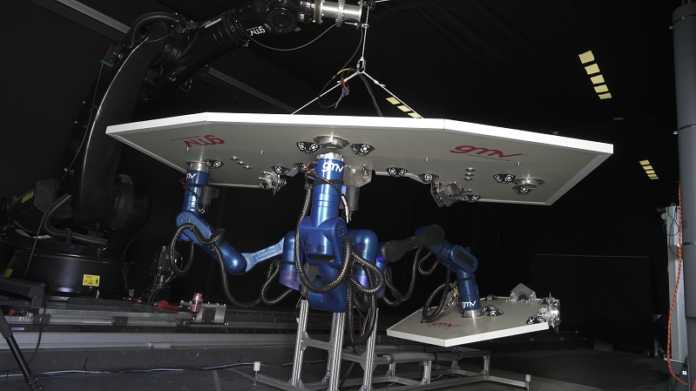
Multinational technology company GMV has successfully concluded ground validation tests for a space robot designed to assemble structures in Earth’s orbit as part of the European Space Agency’s (ESA) MIRROR project (Multi-arm Installation Robot for Readying ORUS and Reflectors). These tests were conducted at GMV’s facilities in Tres Cantos, Madrid, in the Platform-art® robotic laboratory, where conditions resembling those on future space missions are simulated.
Space robotics has been identified by leading European and global space entities as a pivotal technology for the future of the industry. Both the European Space Agency (ESA) and the European Commission (EC) are funding numerous initiatives related to orbital robotic technology, with a vision of establishing an ecosystem of rockets, orbital logistics, and complex robotic systems. This ecosystem aims to facilitate a long-term clean and sustainable presence in space and enable subsequent space exploitation.
GMV develops systems and technology for various space applications, including in-orbit servicing. For instance, they design robotic systems that can be used for repairing, maintaining, enhancing, or refueling satellites in space to extend their operational lifespan. They can also be used for assembling large-scale orbital platforms such as antennas, space‑based solar arrays, and telescopes. Additionally, they can contribute to removing satellites at the end of their operational life, mitigating the accumulation of hazardous space debris around Earth.
In this context, as part of the MIRROR project led by GMV for ESA, GMV has developed and tested a next-generation robotic platform. This autonomous robot is equipped with three arms, which it utilizes for both manipulating and assembling structural modules, as well as for traversing the structure it is assembling. Its three arms allow the robot to move using two of them while employing the third one to transport modules to their assembly points. This unique capability enables it to assemble large structures of any size. To undertake these operations, MIRROR is equipped with a precise vision system consisting of cameras installed near the grippers on each of its arms, and image processing algorithms. In addition to handling modules and moving around, its three arms enable it to receive power, communicate, and use assembly tools (similar to screwdrivers, for example).
MIRROR’s diverse capabilities make it an exceedingly versatile system, poised to usher in new applications that have piqued the interest of leading space agencies and the aerospace industry. Until recently, these applications remained unattainable, both from a technical and economic perspective. One such application involves generating electricity in orbit via photovoltaic solar panels for terrestrial use. These stations would be approximately one kilometer in size, ensuring continuous electricity production around the clock, with the power transmitted to a large ground-based receiving antenna through microwave technology.
Another highly interesting application involves large-scale telescopes for cosmic research, with capabilities significantly enhanced when scaled up to sizes of tens of meters. Further growing interest lies in establishing extensive orbital platforms where telecommunications operators can conveniently install and maintain their equipment.
In the initial phase of the MIRROR project, key features of the structure to be assembled (initially, a telescope reflector) were defined, along with the functional requirements for its components, operational criteria, and testing parameters. Subsequently, GMV, in collaboration with companies such as the Italian LEONARDO, designed the MIRROR robot, capable of meeting the specified requirements, especially regarding mobility, module transportation capacity, and assembly precision. Achieving these required advancements in all subsystems involved, including actuators, power systems, and grippers, along with extensive simulations to confirm the robot’s ability to handle modules of substantial size (approximately 1.2 meters). GMV also developed an advanced semi-autonomous control subsystem with the aim of automating the entire assembly process. The primary goal of this control system is to enable the robot to move and assemble modules despite uncertainties in the gripping points’ positions, and to even detect and recover from any potential failures. The project also encompasses models of the structure to be assembled for testing purposes, as well as a control center that enables various levels of autonomy, ranging from remote control to issuing autonomous commands, such as specifying the assembly of a module at a particular location on the structure.
At present, GMV has successfully concluded validation tests using the demonstrator in its robotic laboratory, Platform-art®, where lighting conditions resembling those in orbit are simulated. This laboratory is also equipped to partially replicate conditions of weightlessness.These tests have successfully proven the concept’s viability, setting the stage for the next development phase aimed at demonstrating these same operations in real tests in Earth’s orbit.
In addition to the MIRROR project, GMV is leading other space robotics projects as part of the ESA, such as the European Moon Rover System, RAPID, or the European Commission’s PERASPERA, which involves the development of the operating system for space robot control (ESROCOS project) and autonomy or artificial intelligence systems (ERGO project).


















